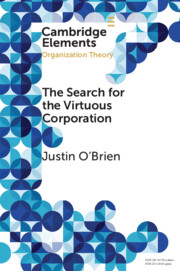Element contents
The Search for the Virtuous Corporation
Published online by Cambridge University Press: 13 September 2021
Summary
- Type
- Element
- Information
- Series: Elements in Organization TheoryOnline ISBN: 9781108979368Publisher: Cambridge University PressPrint publication: 25 November 2021
References
- 8
- Cited by



